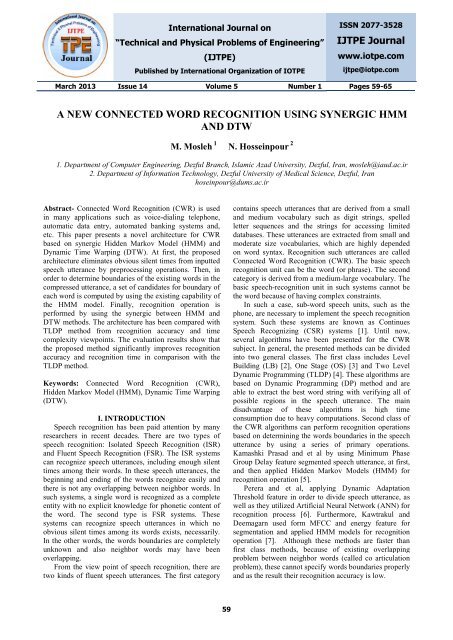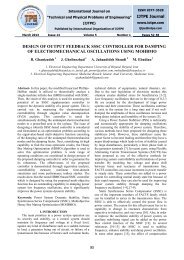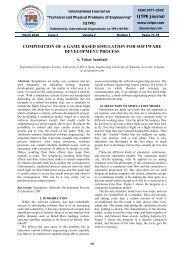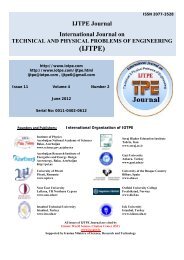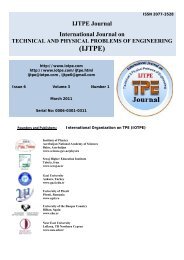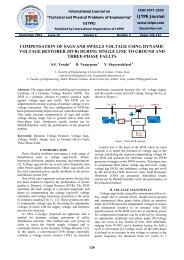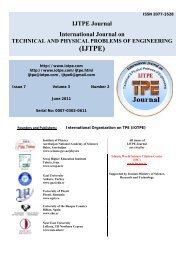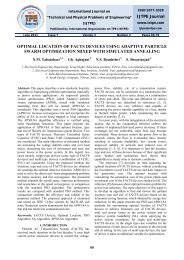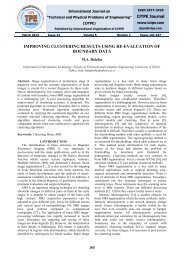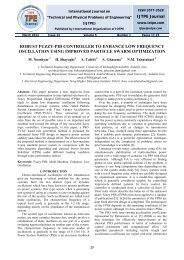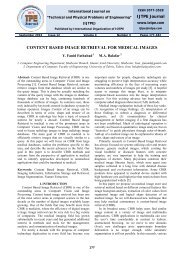9-IJTPE-Issue14-Vol5-No1 - iotpe
9-IJTPE-Issue14-Vol5-No1 - iotpe
9-IJTPE-Issue14-Vol5-No1 - iotpe
Create successful ePaper yourself
Turn your PDF publications into a flip-book with our unique Google optimized e-Paper software.
International Journal on<br />
“Technical and Physical Problems of Engineering”<br />
(<strong>IJTPE</strong>)<br />
Published by International Organization of IOTPE<br />
ISSN 2077-3528<br />
<strong>IJTPE</strong> Journal<br />
www.<strong>iotpe</strong>.com<br />
ijtpe@<strong>iotpe</strong>.com<br />
March 2013 Issue 14 Volume 5 Number 1 Pages 59-65<br />
A NEW CONNECTED WORD RECOGNITION USING SYNERGIC HMM<br />
AND DTW<br />
M. Mosleh 1 N. Hosseinpour 2<br />
1. Department of Computer Engineering, Dezful Branch, Islamic Azad University, Dezful, Iran, mosleh@iaud.ac.ir<br />
2. Department of Information Technology, Dezful University of Medical Science, Dezful, Iran<br />
hoseinpour@dums.ac.ir<br />
Abstract- Connected Word Recognition (CWR) is used<br />
in many applications such as voice-dialing telephone,<br />
automatic data entry, automated banking systems and,<br />
etc. This paper presents a novel architecture for CWR<br />
based on synergic Hidden Markov Model (HMM) and<br />
Dynamic Time Warping (DTW). At first, the proposed<br />
architecture eliminates obvious silent times from inputted<br />
speech utterance by preprocessing operations. Then, in<br />
order to determine boundaries of the existing words in the<br />
compressed utterance, a set of candidates for boundary of<br />
each word is computed by using the existing capability of<br />
the HMM model. Finally, recognition operation is<br />
performed by using the synergic between HMM and<br />
DTW methods. The architecture has been compared with<br />
TLDP method from recognition accuracy and time<br />
complexity viewpoints. The evaluation results show that<br />
the proposed method significantly improves recognition<br />
accuracy and recognition time in comparison with the<br />
TLDP method.<br />
Keywords: Connected Word Recognition (CWR),<br />
Hidden Markov Model (HMM), Dynamic Time Warping<br />
(DTW).<br />
I. INTRODUCTION<br />
Speech recognition has been paid attention by many<br />
researchers in recent decades. There are two types of<br />
speech recognition: Isolated Speech Recognition (ISR)<br />
and Fluent Speech Recognition (FSR). The ISR systems<br />
can recognize speech utterances, including enough silent<br />
times among their words. In these speech utterances, the<br />
beginning and ending of the words recognize easily and<br />
there is not any overlapping between neighbor words. In<br />
such systems, a single word is recognized as a complete<br />
entity with no explicit knowledge for phonetic content of<br />
the word. The second type is FSR systems. These<br />
systems can recognize speech utterances in which no<br />
obvious silent times among its words exists, necessarily.<br />
In the other words, the words boundaries are completely<br />
unknown and also neighbor words may have been<br />
overlapping.<br />
From the view point of speech recognition, there are<br />
two kinds of fluent speech utterances. The first category<br />
contains speech utterances that are derived from a small<br />
and medium vocabulary such as digit strings, spelled<br />
letter sequences and the strings for accessing limited<br />
databases. These utterances are extracted from small and<br />
moderate size vocabularies, which are highly depended<br />
on word syntax. Recognition such utterances are called<br />
Connected Word Recognition (CWR). The basic speech<br />
recognition unit can be the word (or phrase). The second<br />
category is derived from a medium-large vocabulary. The<br />
basic speech-recognition unit in such systems cannot be<br />
the word because of having complex constraints.<br />
In such a case, sub-word speech units, such as the<br />
phone, are necessary to implement the speech recognition<br />
system. Such these systems are known as Continues<br />
Speech Recognizing (CSR) systems [1]. Until now,<br />
several algorithms have been presented for the CWR<br />
subject. In general, the presented methods can be divided<br />
into two general classes. The first class includes Level<br />
Building (LB) [2], One Stage (OS) [3] and Two Level<br />
Dynamic Programming (TLDP) [4]. These algorithms are<br />
based on Dynamic Programming (DP) method and are<br />
able to extract the best word string with verifying all of<br />
possible regions in the speech utterance. The main<br />
disadvantage of these algorithms is high time<br />
consumption due to heavy computations. Second class of<br />
the CWR algorithms can perform recognition operations<br />
based on determining the words boundaries in the speech<br />
utterance by using a series of primary operations.<br />
Kamashki Prasad and et al by using Minimum Phase<br />
Group Delay feature segmented speech utterance, at first,<br />
and then applied Hidden Markov Models (HMM) for<br />
recognition operation [5].<br />
Perera and et al, applying Dynamic Adaptation<br />
Threshold feature in order to divide speech utterance, as<br />
well as they utilized Artificial Neural Network (ANN) for<br />
recognition process [6]. Furthermore, Kawtrakul and<br />
Deemagarn used form MFCC and energy feature for<br />
segmentation and applied HMM models for recognition<br />
operation [7]. Although these methods are faster than<br />
first class methods, because of existing overlapping<br />
problem between neighbor words (called co articulation<br />
problem), these cannot specify words boundaries properly<br />
and as the result their recognition accuracy is low.<br />
59
International Journal on “Technical and Physical Problems of Engineering” (<strong>IJTPE</strong>), Iss. 14, Vol. 5, No. 1, Mar. 2013<br />
This paper presents a novel architecture for the CWR<br />
subject, which can perform recognition operation with<br />
proper speed and accuracy in comparison with the<br />
mentioned methods. In the beginning, the proposed<br />
method compresses the speech utterance to a set of active<br />
parts by eliminating obvious silent parts. Then, in order<br />
to determine existing words boundaries in each active<br />
part, a set of candidates for each boundary word is<br />
obtained by using existing capability of HMM model.<br />
Finally, recognition operation is performed by a synergy<br />
between HMM and Dynamic Time Warping (DTW)<br />
methods. Also, the proposed architecture can apply<br />
grammatical rules in the form of Finite State Automata<br />
(FSA). The proposed method has been compared by the<br />
TLDP method from recognition accuracy and time<br />
complexity viewpoints. The evaluation results show that<br />
the proposed method significantly improves recognition<br />
accuracy and recognition time.<br />
II. PRELIMINARIES<br />
A. Hidden Markov Model (HMM)<br />
HMM is a statistical model that is used for modeling<br />
random sequences in finite state machine form [8]. Just<br />
now, the HMM models are widely applied in speech<br />
recognition domains. These models are robust against<br />
time variants of speech features and variety of speakers.<br />
An N-state HMM with K observations assigned to each<br />
state can be defined as A, B,<br />
where,<br />
ij i | j <br />
A a P q q is a transition probability<br />
NN<br />
matrix which describes a probability from state q i to<br />
( ) k | j <br />
KN<br />
q j .<br />
B b k P V q is an observation probability<br />
matrix which explains the probability of obtaining<br />
symbol in the<br />
probability vector.<br />
q j state. <br />
i 1<br />
N<br />
V k<br />
is an initial<br />
For an observation sequence O o1 , o2<br />
, ..., o T <br />
, P O | probability<br />
and a HMM model A, B,<br />
indicates a likelihood amount between the observation<br />
sequence and the HMM model. The likelihood amount is<br />
obtained with using Viterbi decoding algorithm:<br />
Initialization<br />
1 j j. bj<br />
1 , j 1, 2, ..., N<br />
(1)<br />
Recursion<br />
<br />
<br />
j max i.<br />
b o<br />
<br />
t1 t j t1<br />
t 1, 2, ..., T -1 , 1 i N<br />
Termination<br />
V<br />
| max <br />
<br />
P P O T i<br />
(3)<br />
i 1, 2, ..., N<br />
where N is number of states and T is observation<br />
sequence length.<br />
<br />
B. Dynamic Time Warping (DTW)<br />
The DTW method is an algorithm for measuring<br />
similarity between two patterns that may vary in time.<br />
<br />
(2)<br />
Consider two patterns P 1 and P 2 with M and N frames,<br />
respectively. Alignment measure between P 1 and P 2<br />
patterns by using dynamic time warping technique is<br />
computed according to Equation (4):<br />
<br />
M<br />
<br />
<br />
D( P1 , P2 ) min w( n) d( P1 ( m), P2<br />
( w( m))<br />
<br />
<br />
m1<br />
<br />
(4)<br />
where the distance d ( .,.) is a measure and w ( .) is<br />
warping function.<br />
C. Connected Word Recognition (CWR)<br />
As stated previously, connected word recognizing<br />
system can compute the best existing word sequence in<br />
the speech utterance which has been extracted from a<br />
small and medium vocabulary. In the following, the<br />
manner of the CWR systems operation will be presented.<br />
Assume a test utterance, T, and a set of word reference<br />
patterns, Rv<br />
, 1 v V .<br />
T t 1 , t 2 , ..., t M t m<br />
where <br />
M<br />
<br />
m 1<br />
(5)<br />
t i is corresponding to a feature vector.<br />
v<br />
v<br />
(1), (2), ..., ( ) ( ) N<br />
1<br />
R r r r N r m<br />
(6)<br />
v v v v m<br />
i<br />
where N is the duration of the ith word reference pattern.<br />
The CWR subject can now be considered as an<br />
optimization problem. The main purpose is to find a<br />
*<br />
sequence from of L word reference patterns, R , that<br />
have best matching with test utterance T . Hence, the best<br />
*<br />
sequence of reference patterns, R , is a concatenation of<br />
L reference patterns, i.e.<br />
*<br />
<br />
R R R R<br />
* * ...<br />
*<br />
(7)<br />
q (1) q (2) q ( L)<br />
in which each index,<br />
In order to compute<br />
arbitrary pattern<br />
s<br />
<br />
q<br />
* ( i ) , is in the range [1, V].<br />
s<br />
R of the form<br />
*<br />
R , consider creating an<br />
R R R ... R r ( n)<br />
(8)<br />
where<br />
s s s<br />
q (1) q (2) q ( L) n 1<br />
s<br />
N<br />
s<br />
<br />
is the total duration of the concatenated<br />
reference pattern R . According to Equation (4),<br />
s<br />
alignment measure between R and T can be computed<br />
M<br />
s<br />
<br />
s<br />
<br />
DR , T min w( n)<br />
d t m,<br />
r wm<br />
<br />
m 1<br />
<br />
(9)<br />
<br />
In order to compute the best match, Equation (9) must be<br />
optimized over each possible value L and each reference<br />
word pattern, i.e.<br />
*<br />
<br />
D min D R , T<br />
<br />
s<br />
R<br />
<br />
Lmin<br />
LLmax<br />
1 q( i) V w( m)<br />
m 1<br />
s<br />
<br />
<br />
<br />
M<br />
<br />
<br />
s<br />
<br />
<br />
N<br />
s<br />
<br />
min min min d t m , r w m<br />
s<br />
<br />
<br />
(10)<br />
It should be mentioned that time complexity of direct<br />
calculation of Equation (10) is<br />
<br />
Time Complexity O M L V<br />
(11)<br />
where M is test pattern length, L is number of words in<br />
the test pattern and V is number of reference words.<br />
L<br />
<br />
60
International Journal on “Technical and Physical Problems of Engineering” (<strong>IJTPE</strong>), Iss. 14, Vol. 5, No. 1, Mar. 2013<br />
III. THE PROPOSED METHOD<br />
This section presents a novel architecture for<br />
connected word recognition matter that can apply any<br />
word syntax in order to improve recognition operation.<br />
Figure 1 shows a block diagram of the proposed method.<br />
The proposed method includes two parts: words<br />
boundaries analysis in the inputted speech utterance and<br />
pattern recognition operations. Identifying the words<br />
boundaries is performed in two steps: deleting evident<br />
silent times from the speech utterance and finding short<br />
pauses inter words for determining words boundaries.<br />
The first one is quite easy and causes the inputted<br />
speech utterance is compressed. For this purpose, energy<br />
and zero crossing features together are used. In the<br />
following, feature extraction and vector quantization<br />
operations are performed and as a result observation<br />
sequence is obtained.<br />
The second step is a little more difficult. To determine<br />
short pauses inter words, we use from existing capability<br />
of HMM models. Recall that we use from left-right<br />
HMM for modeling all of the words. As can be seen from<br />
Figure 1, by entering observation sequence to Boundary<br />
Analysis unit, decoding operations based on Viterbi<br />
decoding algorithm [8], are followed in different models<br />
by Likelihood Computation modules starting in the first<br />
state and finally ending the last state. In order to discover<br />
words boundaries, a partial joint likelihood of the last<br />
state is only needed. For the model which adapts to the<br />
input speech utterance, this likelihood will not change<br />
considerable as the word is analyzed from one<br />
observation to next observation until the end of the word.<br />
For each model, when this likelihood exceeds from a<br />
preset threshold value for twice respectively, the pair of<br />
the total likelihood along with the length of passed<br />
observations, (S, L), is resulted. Therefore, each passed<br />
observations length takes in to consideration as a<br />
candidate for the word boundary.<br />
It should be mentioned that the length of passed<br />
observations in each model has to be at least equal to its<br />
corresponding minimum length of all training observation<br />
sequences. The second part of the proposed method refers<br />
to recognition operations. This part is able to determine<br />
the best boundary for each word in the inputted speech<br />
utterance as well as perform recognition operations well.<br />
The manner of its operation will be described in the<br />
following.<br />
As can be observed from Figure 1, the Decision<br />
Maker unit that is placed after the Boundary Analysis unit<br />
receives V pairs Si<br />
, Li<br />
, 1 i V and results in one of<br />
the following outputs:<br />
The first output is the best pair with its corresponding<br />
word index.<br />
The second output is K% of the best pairs with their<br />
corresponding words indexes (K
International Journal on “Technical and Physical Problems of Engineering” (<strong>IJTPE</strong>), Iss. 14, Vol. 5, No. 1, Mar. 2013<br />
Figure 1. Block diagram of the proposed CWR based on synergic HMM and DTW methods<br />
IV. EXPERIMENTAL RESULTS<br />
In order to evaluate the proposed method, the FSA<br />
related to airline booking has been used [9]. This FSA<br />
contains 24 states, 30 transmissions and 28 words. It has<br />
the ability to produce 18 different strings with various<br />
lengths. Training data set includes 2240 speech utterances<br />
that have been uttered by 50 different speakers.<br />
In the beginning, the inputted speech utterances were<br />
divided into 16 ms frames with 8 ms overlapping, and<br />
then evident silent times were removed by using energy<br />
and zero crossing rate features. 12MFCC coefficients<br />
with their energy and dynamics features have been<br />
extracted as features. Training samples have been used<br />
for creating left-right HMM models and templates. In<br />
order to train discrete HMM models, forward-backward<br />
estimation method Baum-Welch has been applied.<br />
Since the number of states in the HMM models have<br />
an important role in performance of the proposed method,<br />
so to achieve higher performance, Self Adaptive HMM<br />
has been used [10]. According to this technique, a model<br />
matches its states with correct states automatically. Such<br />
technique is based on the principle that a model with<br />
correct states has less entropy rather than a model with<br />
incorrect ones.<br />
For testing the proposed system, two classes of<br />
connected word-utterances have been used. First class<br />
contains the utterances which have been uttered in the<br />
FSA format. These utterances have different lengths<br />
between four to eight words (called 4-FSA to 8-FSA).<br />
The second class contains speech utterances which don't<br />
have certain format. In the other word, these utterances<br />
necessarily have not been uttered in the FSA format and<br />
can be random combination of the vocabulary words.<br />
Error rate is calculated by using following Equation [11]:<br />
#Sub #Del #Ins<br />
ERR(%) 100 (12)<br />
#words in the speech utterance<br />
where,<br />
Sub: an incorrect word was substituted for the correct<br />
word<br />
Del: a correct word was omitted in the recognized<br />
sentence<br />
Ins: an extra word was added in the recognized<br />
sentence<br />
As was mentioned, the most problem of the CWR<br />
systems is inability for proper determining of words<br />
boundaries in the inputted speech utterance. Although,<br />
until now, many methods have been presented for the<br />
CWR subject, but none of them don’t have recognition<br />
accuracy of the TLDP method. This method is a wellknown<br />
CWR algorithm that assigns a proper word string<br />
to inputted speech utterance. The most important its<br />
deficiency is high time complexity, which caused it is not<br />
proper for real time applications. A. Agbago and C.<br />
Barrier applied a modified TDLP in the CSR systems for<br />
recognizing phoneme sequences [12]. Furthermore, Y.<br />
Kim and H. Jeong presented hardware solution for real<br />
time execution of the TLDP method on Field<br />
Programmable Gate Array (FPGA) [13]. Therefore, the<br />
proposed method has been compared with this algorithm.<br />
The obtained results from comparison have been shown<br />
in Tables 1, 2, respectively.<br />
As can be seen from the Table1, 2, the average of<br />
error rate in the TLDP method and the proposed method<br />
are 27.37% and 12.71% in the formal format utterances<br />
as well as 28.11% and 26.08% in the informal format<br />
utterances, respectively. Therefore, recognition accuracy<br />
of the proposed method in the formal format utterances is<br />
more than twice recognition accuracy of the TLDP<br />
method while in the informal format utterances is close.<br />
The percentage of error rate for the substitution, deletion<br />
and insertion errors in the TLDP method and the<br />
proposed method have been shown in the Figure 3.<br />
62
International Journal on “Technical and Physical Problems of Engineering” (<strong>IJTPE</strong>), Iss. 14, Vol. 5, No. 1, Mar. 2013<br />
Figure 2. Flowchart the manner of function of the proposed method<br />
Table 1. The obtained results of evaluating the proposed method with the TLDP method for formal connected word-utterances<br />
Hypothesis<br />
5-FSA 6-FSA 7-FSA 8-FSA<br />
No. of utterances 64 31 67 45<br />
No. of Substitution<br />
TLDP method 47 25 77 64<br />
The proposed method 29 14 43 28<br />
No. of Deletion<br />
TLDP method 21 16 23 22<br />
The proposed method 5 4 7 10<br />
No. of Insertion<br />
TLDP method 15 13 20 16<br />
The proposed method 6 7 7 8<br />
The TLDP error rate (%) 25.93 29.03 26.22 28.33<br />
The proposed method error rate (%) 12.50 13.44 12.15 12.77<br />
Table 2. The obtained results of evaluating the proposed method with the TLDP method for informal connected word-utterances<br />
No. of utterances 150<br />
No. of words 690<br />
No. of substitution<br />
TLDP method 125<br />
The proposed method 129<br />
No. of Deletion<br />
TLDP method 41<br />
The proposed method 17<br />
No. of Insertion<br />
TLDP method 28<br />
The proposed method 34<br />
The TLDP error rate (%) 28.11<br />
The proposed method error rate (%) 26.08<br />
63
International Journal on “Technical and Physical Problems of Engineering” (<strong>IJTPE</strong>), Iss. 14, Vol. 5, No. 1, Mar. 2013<br />
Error rate (%)<br />
Error rate(%)<br />
The TLDP Method<br />
20<br />
15<br />
10<br />
5<br />
0<br />
0 2 4 6 8 10<br />
Length of Hypothesis<br />
The Proposed Method<br />
10<br />
8<br />
6<br />
4<br />
2<br />
Substitution<br />
Deletion<br />
Insertion<br />
Substitution<br />
Deletion<br />
Insertion<br />
DTW is average cost of the DTW method. Therefore,<br />
the proposed method is associated with two important<br />
characteristics which can result in significant decreasing<br />
of time complexity:<br />
1. Compressing the inputted speech utterance length by<br />
using deleting silent times.<br />
2. Finding words boundaries in the inputted speech<br />
utterance by evaluating few regions instead of all possible<br />
regions by using applying the capability of the HMM<br />
method.<br />
Therefore, such capabilities caused numerous<br />
decreasing of the DTW calls and so the proposed<br />
architecture is able to do the CWR with very appropriate<br />
speed in comparison with the TLDP method.<br />
Figure 3. The percentage of error rate for the substitution, deletion<br />
and insertion errors in the TLDP method and the proposed architecture<br />
According to Equation (12), the total error rate is<br />
related to the substitution, deletion and insertion errors.<br />
The substitution error refers to part of the system error<br />
that is the result of incorrect pattern matching operations<br />
while the insertion and deletion errors are assigned to<br />
system inability to determine proper boundary of the<br />
words in the inputted speech utterance.<br />
As can be seen from Figure 3, the substitution error<br />
rate in the proposed method is much more than the sum<br />
of the deletion and insertion errors. So, it can be<br />
concluded that the proposed method can overcome to coarticulation<br />
problem between adjacent words is able to<br />
determine words boundaries in the inputted speech<br />
utterance properly. Figure 4 shows deleting of evident<br />
silent times and specifying the words boundaries in the<br />
inputted speech utterance using the proposed method.<br />
(a)<br />
(b)<br />
Figure 4. (a) Deleting of evident silent times by pre-processing<br />
operations (b) Determining of words boundaries by the synergic the<br />
HMM and DTW methods<br />
<br />
0<br />
0 2 4 6 8 10<br />
The Time complexity of the TLDP method equals to<br />
<br />
Length of Hypothesis<br />
O M V DTW where M is the inputted speech<br />
utterance length, V is number of reference patterns and<br />
V. CONCLUSIONS<br />
In this paper, a new architecture for recognizing<br />
connected words has been presented. At the beginning,<br />
the proposed method compresses the input string with<br />
eliminating the obvious silent times through<br />
preprocessing operations. Then the proposed method<br />
extract the best sequence of words by synergy between<br />
the HMM and the DTW methods. Also, this proposed<br />
system can apply grammatical rules in the form of the<br />
FSA. The proposed method has been compared with the<br />
TLDP method from views of recognition accuracy and<br />
time complexity. The evaluation results show that the<br />
proposed method has better recognition accuracy and<br />
very lower time complexity than the TLDP method.<br />
REFERENCES<br />
[1] L. Rabiner, B. Juang, “Fundamentals of Speech<br />
Recognition”, Prentice Hall, 1993.<br />
[2] C. Myers, L. Rabiner, “A Level Building Dynamic<br />
Time Warping Algorithm for Connected Word<br />
Recognition”, IEEE Transactions on Acoustics Speech<br />
and Signal Processing, Vol. 29, No. 2, pp. 284-297, April<br />
1981.<br />
[3] J.S. Bridle, M.D. Brown, R.D. Chamberlain,<br />
“Continuous Connected Word Recognition Using Whole<br />
Word Templates”, Radio and Electronic Engineer, Vol.<br />
53, No.4, pp. 167-175, April 1983.<br />
[4] H. Sakoe, “Two-Level DP-Matching - A Dynamic<br />
Programming Based Pattern Matching Algorithm for<br />
Connected Word Recognition”, IEEE Transactions on<br />
Acoustics, Speech and Signal Processing, Vol. 27, No. 6<br />
pp. 588-595, December 1979.<br />
[5] V. Kamakshi Prasad, T. Nagarajan, H.A. Murthy,<br />
“Automatic Segmentation of Continuous Speech Using<br />
Minimum Phase Group Delay Functions”, Speech<br />
Communication, Issue 3-4, Vol. 42, pp. 429-446, April<br />
2004.<br />
[6] K.A.D. Perera, R.A.D.S. Ranathunga, I.P.<br />
Welivitigoda, R.M. Withanawasam, “Connected Speech<br />
Recognition with an Isolated Word Recognizer”, Proc.<br />
International Conference on Information and Automation,<br />
pp. 319-323, Colombo, Sri Lanka, December 2005.<br />
[7] A. Deemagarn , A. Kawtrakul, “Thai Connected Digit<br />
Speech Recognition Using Hidden Markov Models”,<br />
Proc. International Conference on Speech and Computer<br />
64
International Journal on “Technical and Physical Problems of Engineering” (<strong>IJTPE</strong>), Iss. 14, Vol. 5, No. 1, Mar. 2013<br />
(SPECOM), pp. 731-735, Saint-Petersburg, Russia,<br />
September 2004.<br />
[8] L.R. Rabiner, “A Tutorial on Hidden Markov Models<br />
and Selected Applications in Speech Recognition”, Proc.<br />
IEEE, Vol. 77, No. 2, pp. 257-286, February 1989.<br />
[9] F. Owens, “Signal Processing of Speech”, Macmillan<br />
Publishing Company, 1993.<br />
[10] J. Li, J. Wang, Y. Zhao, Z. Yang, “Self-Adaptive<br />
Design of Hidden Markov Models”, Pattern Recognition<br />
Letters, Issue 2, Vol. 25, pp. 197-210, January 2004.<br />
[11] X. Huang, A. Acero, H. Hon, “Spoken Language<br />
Processing”, Prentice Hall PTR, 2001.<br />
[12] A. Agbago, C. Barrier, “Fast Two-Level Dynamic<br />
Programming Algorithm for Speech Recognition”, Proc.<br />
ICASSP, Vol. 5, 2004.<br />
[13] Y. Kim, H. Jeong, “A Systolic FPGA Architecture<br />
of Two-level Dynamic Programming for Connected<br />
Speech Recognition”, IEICE Transactions on Information<br />
and Systems, Vol. E90-D, No. 2, pp. 562, February<br />
2007.<br />
BIOGRAPHIES<br />
Mohammad Mosleh received the<br />
B.Sc. degree in Computer Hardware<br />
Engineering from Dezful Branch,<br />
Islamic Azad University, Dezful, Iran<br />
in 2003, and the M.Sc. Ph.D. degrees<br />
in Architecture of Computer Systems<br />
from Science and Research Branch,<br />
Islamic Azad University, Tehran,<br />
Iran, in 2006 and 2010, respectively. He is an Assistant<br />
Professor in the Department of Computer Engineering at<br />
Dezful Branch, Islamic Azad University. His main<br />
research interests are in the areas of speech processing,<br />
machine learning, intelligent systems and audio<br />
watermarking.<br />
Najmeh Hosseinpour received the<br />
B.Sc. degree in Electronics<br />
Engineering from Dezful Branch,<br />
Islamic Azad University, Dezful, Iran<br />
in 2009 and the M.Sc. degree in<br />
Architecture of Computer Systems<br />
from the same university in 2012. Her<br />
main research activities cover the<br />
areas of intelligent systems, speech recognition and<br />
speaker recognition.<br />
65


